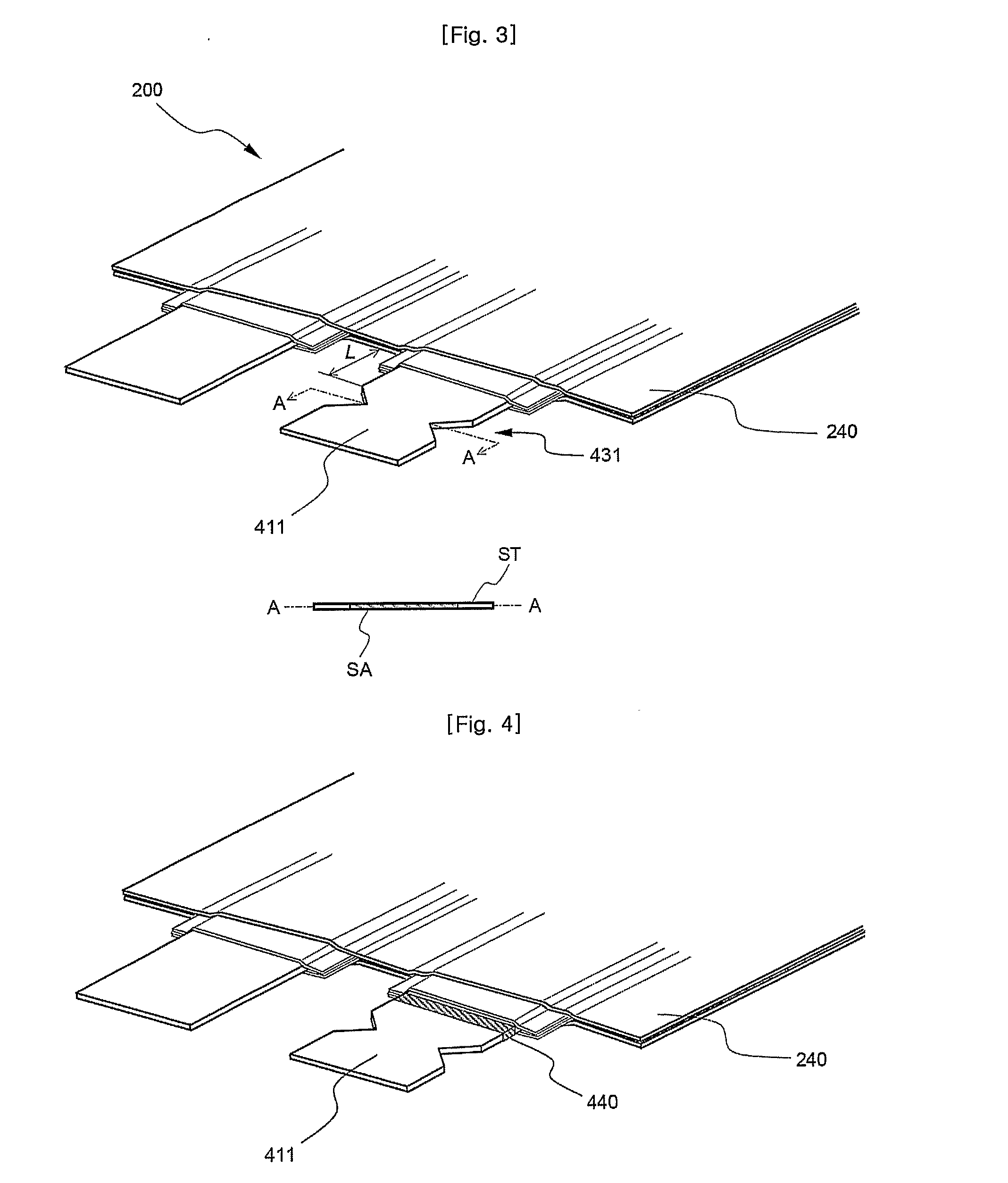Secondary battery having electrode with self cutting part to be destructed on application of over-current
a secondary battery, self-cutting technology, applied in the field of secondary batteries, can solve the problems of reducing the safety of a middle- or large-sized battery pack, low mechanical strength of the battery case, and low safety of lithium secondary batteries, so as to prevent the progress of the battery, prevent the effect of heat generation and high hea
- Summary
- Abstract
- Description
- Claims
- Application Information
AI Technical Summary
Benefits of technology
Problems solved by technology
Method used
Image
Examples
example 1
[0078]Notches as shown in FIG. 3 were formed in opposite sides of the cathode tap of the pouch-shaped secondary battery prepared according to Comparative example 1. The notches were formed such that the center of the notches was spaced by 1.5 cm from the sealing part of the battery case and the notches had a width of 5 mm.
[0079]The experiment results obtained after overcurrent was supplied to the secondary battery in the same manner as Comparative example 1 was shown in FIGS. 11 and 12.
[0080]Referring to these drawings together with the results of examination with the naked eye, the cathode tap of the secondary battery broke after approximately 0.8 seconds when approximately 1690 A of overcurrent was supplied to the secondary battery. However, the sealing part of the battery case was not separated, and the secondary battery did not catch fire.
example 2
[0081]A through-hole as shown in FIG. 6 was formed in the cathode tap of the pouch-shaped secondary battery prepared according to Comparative example 1. The through-hole was formed in the middle region of the cathode tap such that the through-hole had a size corresponding to approximately 40% of the surface area of the cathode tap.
[0082]The experiment results obtained after overcurrent was supplied to the secondary battery in the same manner as Comparative example 1 was shown in FIGS. 13 and 14.
[0083]Referring to these drawings together with the results of examination with the naked eye, the cathode tap of the secondary battery broke after approximately 1.6 seconds when approximately 1600 A of overcurrent was supplied to the secondary battery. The sealing part of the battery case was slightly separated; however, the secondary battery did not catch fire.
example 3
[0084]Two through-holes as shown in FIG. 7 were formed in the cathode tap of the pouch-shaped secondary battery prepared according to Comparative example 1. The through-holes were formed in the middle region of the cathode tap such that each through-hole had a size corresponding to approximately 25% of the surface area of the cathode tap. Also, the through-holes were arranged such that the through-holes were spaced approximately 2 mm from each other.
[0085]The experiment results obtained after overcurrent was supplied to the secondary battery in the same manner as Comparative example 1 was shown in FIGS. 15 and 16.
[0086]Referring to these drawings together with the results of examination with the naked eye, the cathode tap of the secondary battery broke after approximately 1.0 second when approximately 1600 A of overcurrent was supplied to the secondary battery. However, the sealing part of the battery case was not separated, and the secondary battery did not catch fire.
[0087]As can ...
PUM
 Login to View More
Login to View More Abstract
Description
Claims
Application Information
 Login to View More
Login to View More - R&D
- Intellectual Property
- Life Sciences
- Materials
- Tech Scout
- Unparalleled Data Quality
- Higher Quality Content
- 60% Fewer Hallucinations
Browse by: Latest US Patents, China's latest patents, Technical Efficacy Thesaurus, Application Domain, Technology Topic, Popular Technical Reports.
© 2025 PatSnap. All rights reserved.Legal|Privacy policy|Modern Slavery Act Transparency Statement|Sitemap|About US| Contact US: help@patsnap.com



